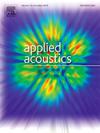Study on the nonlinear interaction characteristics between rail cracks and ultrasonic based on finite element-spectral element coupling method
IF 3.4
2区 物理与天体物理
Q1 ACOUSTICS
引用次数: 0
Abstract
This study addresses nonlinear ultrasonic wave propagation induced by rail cracks. The domain decomposition theory of finite element–spectral element coupling underpins a computational method that combines the nonlinear effects in the crack region with far-field linear elastic behavior to investigate the nonlinear interactions between cracks and ultrasonic waves. The results show that the nonlinear parameter correlates positively with crack length and angle, reaching its maximum at 6 mm and 90°, approximately 11 times higher than at 0°. The crack angle influences the scattering energy coefficient with a “U-shaped” distribution, showing the highest values at 0° and 90° and lower values between 15° and 60°; at a fixed angle, the scattering energy coefficient increases significantly with crack length. Simulation and experimental errors remain within 5 %, fully validating the numerical results.
基于有限元-谱元耦合方法的钢轨裂缝与超声波非线性相互作用特性研究
本研究探讨了由钢轨裂缝引起的非线性超声波传播问题。该计算方法将裂纹区域的非线性效应与远场线性弹性行为相结合,研究了裂纹与超声波之间的非线性相互作用。结果表明,非线性参数与裂纹长度和角度呈正相关,在 6 毫米和 90° 时达到最大值,比 0° 时高约 11 倍。裂纹角度对散射能量系数的影响呈 "U "型分布,在 0° 和 90° 时数值最大,在 15° 和 60° 时数值较小;在固定角度时,散射能量系数随裂纹长度的增加而显著增加。模拟和实验误差保持在 5% 以内,充分验证了数值结果。
本文章由计算机程序翻译,如有差异,请以英文原文为准。
求助全文
约1分钟内获得全文
求助全文
来源期刊

Applied Acoustics
物理-声学
CiteScore
7.40
自引率
11.80%
发文量
618
审稿时长
7.5 months
期刊介绍:
Since its launch in 1968, Applied Acoustics has been publishing high quality research papers providing state-of-the-art coverage of research findings for engineers and scientists involved in applications of acoustics in the widest sense.
Applied Acoustics looks not only at recent developments in the understanding of acoustics but also at ways of exploiting that understanding. The Journal aims to encourage the exchange of practical experience through publication and in so doing creates a fund of technological information that can be used for solving related problems. The presentation of information in graphical or tabular form is especially encouraged. If a report of a mathematical development is a necessary part of a paper it is important to ensure that it is there only as an integral part of a practical solution to a problem and is supported by data. Applied Acoustics encourages the exchange of practical experience in the following ways: • Complete Papers • Short Technical Notes • Review Articles; and thereby provides a wealth of technological information that can be used to solve related problems.
Manuscripts that address all fields of applications of acoustics ranging from medicine and NDT to the environment and buildings are welcome.
 求助内容:
求助内容: 应助结果提醒方式:
应助结果提醒方式:


